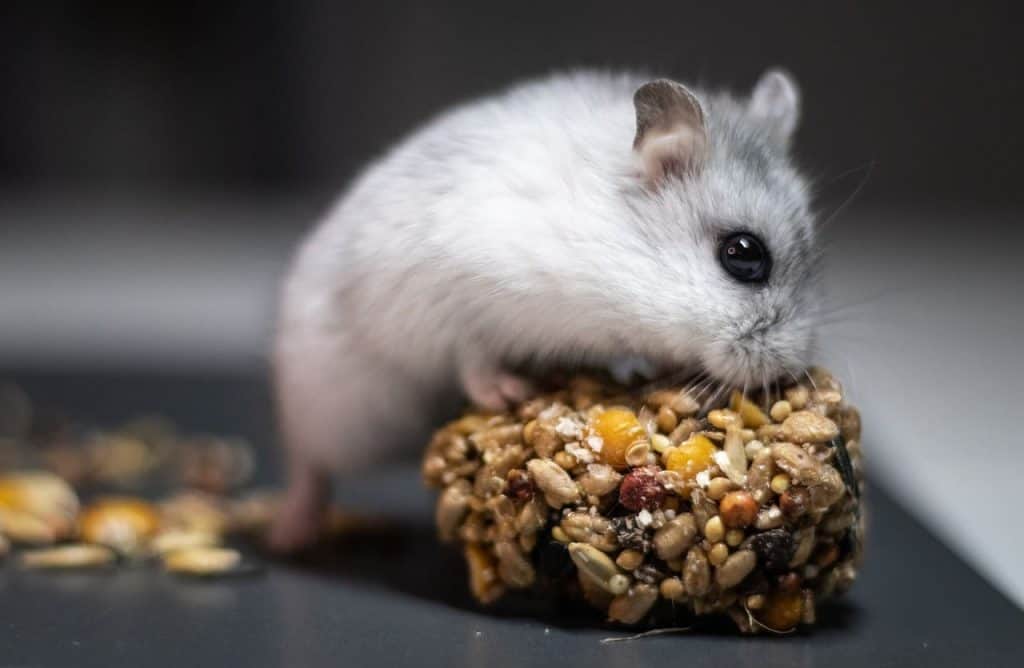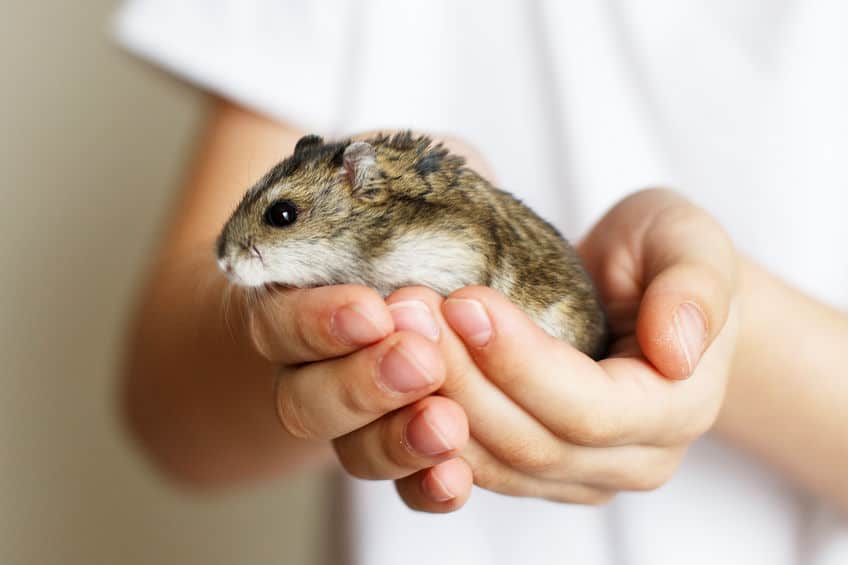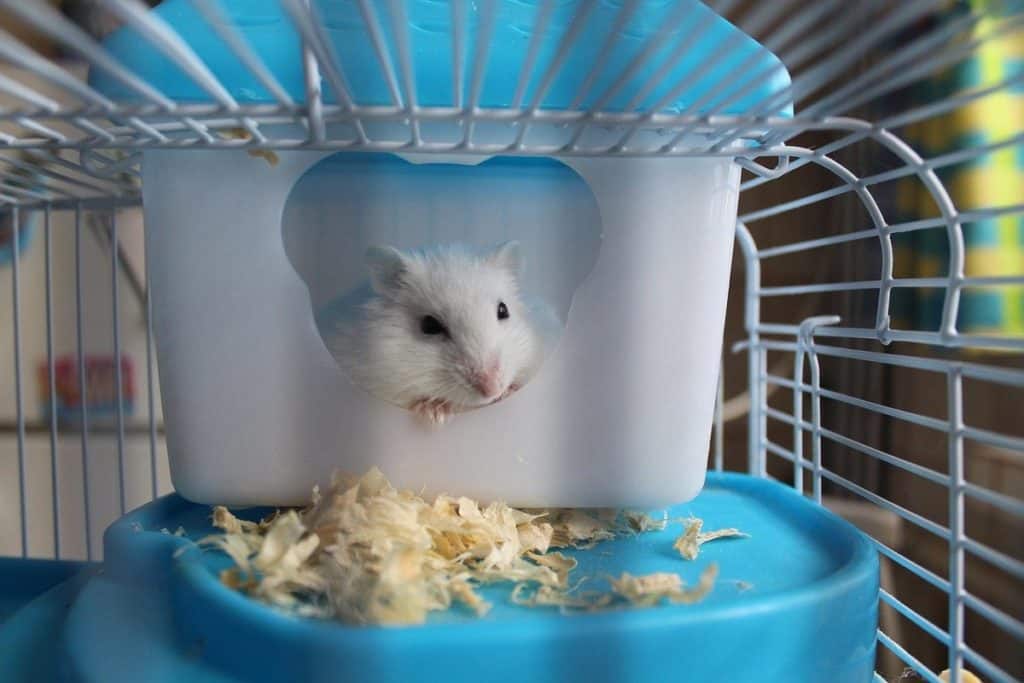When you bring home a new pet, it can be a bit overwhelming trying to figure out how exactly you should take care of your new furry friend. In this article, you will find the answer to many of the questions you may have about caring for a hamster.
We are going to go over things like how to pick out a hamster, what to feed your hamster, and what cage size you should get for your hamster. Once you’re done reading, you should know exactly what you need to know to give your hamster a happy new home.
1. Hamster Care: What Hamster Breed Should You Go For?
There are 5 main breeds of hamsters that you can choose from and each has its own characteristics, temperament, and care needs. Let’s have a look at each of them to help you decide which one is the right breed for you. The good news is, there is no “good” or “bad” breed – all of them make for great pets alike, so it’s really down to your personal choice.
1. Syrian Hamster

Syrian hamsters, also commonly referred to as golden hamsters due to their coloring, is the largest breed of hamster that you can keep as a pet. They tend to get up to about 5.5 inches in length and generally live for about three years.
Syrian hamsters are one of the most popular pet hamster breeds because they tend to be pretty playful and fun to watch. However, they should always be kept by themselves because they tend to be very territorial and sometimes aggressive, even towards offspring.
2. Roborovski Dwarf Hamsters

On the other end of the scale size-wise, Roborovski dwarf hamsters are one of the smallest hamster breeds. Even adult Roborovski hamsters tend to be no bigger than three inches in length. However, despite their small size, they actually tend to have the longest lifespan, often living close to 4 years.
As far as temperament, these hamsters are extremely fast and active, which can make them more difficult to handle. But they are really fun to watch and come in a range of different coat colors, so you have more options than you do with some other breeds.
3. Russian Winter White Dwarf Hamsters

Russian winter white dwarf hamsters live about two years in captivity, which is substantially shorter than the Roborovksi dwarf hamster, but they are much easier to handle. In fact, many people find the Russian winter white dwarf hamster to be one of the easiest to handle. However, you should still handle them with care and start off doing so when they are young.
Despite their name, these hamsters are usually dark grey in captivity. They have the name “winter white” because, in the wild, they actually shed their darker coat for a completely white coat every winter, but this does not typically happen with captive Russian winter whites.
4. Campbell’s Dwarf Hamsters

If you are wanting a dwarf hamster, the Campbell dwarf hamster is one of the most popular breeds available. They live an average of 2 years and have a fairly distinctive look with tiny, round ears and a gray-brown coat. As far as temperament, they do fairly well being handled as long as they are handled by humans from a young age, but they do nip if they are feeling threatened or stressed.
5. Chinese Dwarf Hamsters

Chinese dwarf hamsters are one of the most unique-looking hamsters that you can get. They have a long tail and almost always have a long black stripe coming down their back along the spine. They actually look somewhat similar to a mouse. The Chinese dwarf hamster also has one of the shortest lifespans, usually living for slightly less than two years.
As far as temperament, they are generally pretty sweet and are comfortable being held and handled. But they are very small and quick, which can come with some challenges if you are hoping to have a hamster that will just sit in your arms for long periods of time.
2. How To Choose Your Hamster From a Pet Shop or Breeder
Before you go to get your hamster, you are going to want to decide what type of hamster you want to get. The previous section should help you decide based on things like the temperament are look you are wanting. Some breeders or pet stores sell multiple breeds of hamsters, so you may be able to make your final decision when you get there, but it is helpful to have some idea of what you want beforehand.
Next, you need to figure out if you want to get your hamster from a pet store or directly from a breeder. There are pros and cons to both. If you go with a pet store, the hamster will likely cost you less money, but you will not have as much information about where the hamster came from. A breeder will be able to provide you with a lot more background information that could let you know what to expect from your hamster as far as potential health problems and temperament.
Once you pick where you are going to get your hamster from, you should take a look at the available hamsters and try to pick a healthy one. Your hamster should have:
- clean ears,
- no bald spots,
- no unusual lumps,
- bright eyes without built-up gunk,
- a slightly rounded stomach,
- healthy teeth (not overgrown/curled upwards).
Keep in mind that all hamsters have scent glands on their thighs that might look like scabs or cuts but are actually completely normal.
After you pick out the hamster you want, ask if you can hold the hamster or at least put your hand up to the cage. Hamsters that sniff at your hand but do not aggressively bite or scratch at you generally have the best temperament when it comes to being able to handle them. As long as you are happy with the temperament and the hamster seems healthy, you are good to go.
3. Proper Hamster Care Means Buying The Right Type of Cage
Generally speaking, you are going to want to buy your hamster’s cage ahead of time, but you can set it up when you get home with your hamster if you have to. When it comes to the size of your hamster cage, you want the biggest cage that you can get, which means many of the cages marketed for hamsters will not be large enough. A general rule of thumb is that you want at least 450 square inches of floor space per dwarf hamster. That is a cage that is approximately 30 inches by 15 inches and 12 inches tall. A Syrian hamster requires a larger cage – at least 600 square inches of continuous floor space.
There are two types of cages that you can consider getting. The first is a wire cage, but you’re going to want to make sure it has a plastic base both to hold in bedding and to protect your hamster’s feet. The other option is a glass tank or aquarium. This will allow you to layer more bedding which is great for hamsters who like to burrow, but you want to make sure you use a cage with a wire or mesh top for ventilation.
4. Accessories You Should Put Inside The Cage

When setting up your hamster cage, there are a number of things you will want to keep inside your cage at all times to keep your hamster happy and healthy.
- Bedding: You need to get hamster-safe bedding and layer it into the cage pretty thick. This gives your hamster a comfortable place to walk, sleep, etc., but it also allows your hamster to burrow, which he will likely instinctively want to do.
- Food and Water: You will want to get a food dish of some sort and a water bottle or dish. Most owners decide to go with a water bottle because it has less chance of spillage. Remember, you are going to want to have multiple foods and water spots if you are keeping multiple hamsters together.
- Wheel: Wheels are important to your hamster’s physical and mental well-being. In the wild, hamsters will run for miles at a time, and a wheel will allow your hamster to get some of that energy out while in his enclosure.
- Chew Sticks and Toys: Hamsters’ teeth never stop growing, so they have to chew in order to keep them healthy. There are lots of different types of chew toys available such as wooden blocks and chew sticks. You can even use cardboard tubes.
- Climbing Structures: Many hamsters like to climb, so offering your hamster some type of climbing toy(s) will allow him to exercise both his body and his brain.
- Hideaways: In the wild, hamsters are pretty low on the food chain, so they only sleep in burrows or underneath things as a protective measure. Even in captivity, your hamster will likely only be comfortable sleeping when he is hidden away, so offering hideaways will help make your hamster more comfortable.
5. Cleaning Your Hamster Cage: How and How Often?
Pretty much every day, you are going to want to spot-clean your hamster’s cage. That means removing any bedding that has been soiled, changing out the water, and cleaning out any old food. You are also going to want to completely wipe out any food bowls every few days.
However, you only need to do a deep clean every couple of weeks, depending on how dirty your hamster is. During a deep clean, you will completely remove everything in your hamster’s enclosure, including the wheel, toys, bowls, etc., and you will wipe them all down thoroughly with soap and water. Next, you will take out all of the bedding. After the cage is completely empty, wipe it down with soap and water. Once you have dried the enclosure, put in fresh bedding, and then add in all the extras like the bowls, water bottles, toys, etc.
6. Good Hamster Care: Healthy Food and Treats

Proper hamster care means that you want to give your hamster a diet that is both safe and well-balanced. Many companies make hamster food in the form of pellets that are specifically designed for hamsters, though you should always check the ingredient list to make sure it is a good formula. These pellets should usually make up the bulk of your hamster’s diet.
As far as treats go, they do sell hamster treats, but you can also use fruits and vegetables that your hamster will be sure to love. Try things like carrots, cucumbers, lettuce, celery, apples, and bananas, and just see what your hamster likes.
7. Bonding With and Handling Your Hamster
When you first bring your hamster home, you should give your hamster some time to acclimate to his new space. Generally speaking, you should give your hamster up to three days just to become used to his new environment, but then you should start gradually introducing yourself. Start by approaching the cage while talking to your hamster (so you do not startle him.)
Then you want to start taming your hamster or getting him used to being handled by you. Start by just reaching your hand in the cage and letting him sniff you. Then you can try petting and eventually holding your hamsters. Make all movements slow and with control, so you do not startle your hamster. Additionally, it is best not to force your hamster to wake up or stop resting. Handle your hamster when he is already awake and active. After a few weeks, your tame hamster will be much more comfortable around you and will even start showing his affection.
8. Hamster Exercise: Why And How?
Hamsters in the wild get lots of exercise. They tend to run and explore for miles every single night in search of food and other resources. They also do things like digging their own homes/burrows, which takes a good bit of physical exertion. In captivity, hamsters do not always have these same opportunities to exercise, so you need to make sure you offer your hamster other options to keep him healthy.
The most important thing you can do is offer your hamster a wheel that he can run on. Other things you can do include providing your hamster with climbing toys and tunnels and plenty of bedding so he can dig. It is also a good idea to give your hamster time outside of his enclosure to explore in a controlled, safe environment.
9. How To Prevent Hamster Accidents
The most important thing you can do is control who has access to your hamster. Make sure your hamster is kept somewhere that other pets in your household cannot get him. Even the sweetest pets can be dangerous to small animals like hamsters. You also want to make sure that any people who have access to your hamster know how to do so with care.
Additionally, the most likely time for accidents to occur is when your hamster is out of its enclosure. Now, this time out of the enclosure is important for your hamster; you just want to make sure that it is in a controlled space away from any pets and that everyone in your household knows he is out and not to let any other animals in. You also want to remove any clothes and choking hazards from the floor.
10. Common Hamster Health Issues And What To Do About It
There are a variety of different potential health issues that your hamster may deal with, such as cheek pouch impaction, eye issues, tooth issues, heart disease, bladder stones, skin problems, obesity, diabetes, diarrhea, respiratory problems, or cancer.
For pretty much any of these health problems, you are going to want to check with your local vet, but the good news is that many of these health problems are completely manageable with medicine, a balanced diet, and other care changes. Monitoring your pet’s health will help him live a longer and healthier life overall.
Frequently Asked Questions About Hamster Care
Is it easy to take care of a hamster?
As far as pets go, hamsters are relatively easy to take care of, but they still require commitment and time. You have to be able to provide them with everything they need (food, toys, vet care, etc.) and have the time to provide them with a clean environment and meet their other needs, such as time out of the enclosure.
Is a hamster a good pet?
If you want a small pet, hamsters often make excellent pets. They are lots of fun to watch and can also be fun to hold and play with. It also helps that they are relatively low maintenance. However, it does somewhat depend on what you are looking for in a pet. But overall, hamsters do make great pets.
Do hamsters like to be held?
This does depend on the breed of your hamster in addition to your individual hamster. Some hamsters really love to be held and handled by people, while other hamsters would really be happiest if you left them alone all day in their enclosure. There are also some hamsters that are completely indifferent to the matter. If you would like to hold your hamster a lot, it is best to start doing so while your hamster is young and continue to do so every single day, at least for a little while each day,
Do hamsters need baths?
For the most part, you will never need to give your hamster any sort of bath. Similar to cats, hamsters are self-groomers. This means that they do a pretty good job of keeping themselves clean. However, if your hamster ever gets especially messy, you can use a slightly damp cloth to gently wipe him clean. But you never need to dunk your hamster into water or give him a wet bath.
See also:
- Hamster VS Mouse VS Rat: Which one is the best pet?
- 8 Signs your little hamster has unfortunately passed away
Contents
- 1. Hamster Care: What Hamster Breed Should You Go For?
- 2. How To Choose Your Hamster From a Pet Shop or Breeder
- 3. Proper Hamster Care Means Buying The Right Type of Cage
- 4. Accessories You Should Put Inside The Cage
- 5. Cleaning Your Hamster Cage: How and How Often?
- 6. Good Hamster Care: Healthy Food and Treats
- 7. Bonding With and Handling Your Hamster
- 8. Hamster Exercise: Why And How?
- 9. How To Prevent Hamster Accidents
- 10. Common Hamster Health Issues And What To Do About It
- Frequently Asked Questions About Hamster Care













